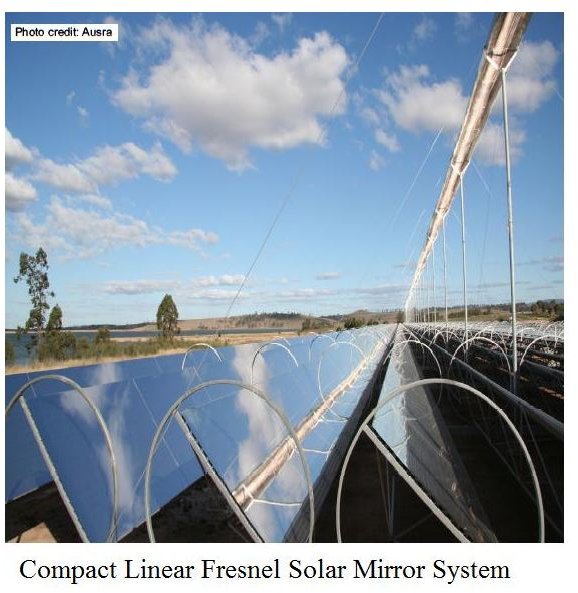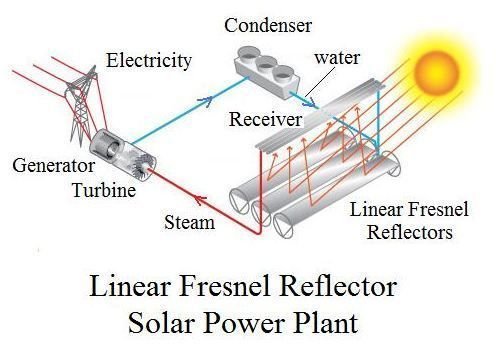The Compact Linear Fresnel Reflector System as a Solar Concentrator for Electricity from Solar Power
Introduction
The linear solar fresnel solar power system, often called compact linear fresnel reflector (CLFR) technology, uses a series of linear solar mirrors, but each solar mirror is flat instead of the more expensive parabolic shape used for a parabolic trough solar plant. This is one of the solar concentrator technologies being developed to improve the efficiency for conversion of solar power to electricity. An introduction to the four leading concentrating solar power technologies is available in another article.
General Description of a Linear Solar Fresnel Solar Plant
A linear solar fresnel solar plant uses an array of single axis, linear solar mirrors to reflect sunlight onto a receiver tube. In that way it is similar to a solar parabolic trough system. The compact linear fresnel solar power system, however, uses a ‘parabola’ made up of ten flat mirrors that each rotate to follow the sun, Instead of a more expensive parabolic shaped mirror, as in the solar parabolic trough system.This type of system allows the

flat solar mirrors to remain near the ground, avoiding wind loads. The diagrams in this section show a couple different views of a set of compact linear fresnel mirrors with an absorber tube above them.
Current designs for the linear solar fresnel system heat water to produce steam at 545oF in the absorber tubes. The steam is used directly to drive a turbine in a standard Rankine cycle to produce electricity, avoiding the need for a heat exchanger to produce steam from some other high temperature fluid.
Advantages and Disadvantages of a Solar Fresnel Solar Power System
Here are some advantages and disadvantages of a solar fresnel solar plant in comparison with the other three concentrating solar power technologies introduced in the first article of this series: heliotrope solar tower, solar parabolic trough, and solar parabolic dish - stirling engine system.
Advantages
-
Flat solar mirrors used in the solar fresnel technology are less expensive than the parabolic shaped solar mirror of the

parabolic trough or the parabolic dish.
-
The absorber tube is simpler and less expensive than that of the parabolic trough system, because multiple solar mirrors reflect solar power to a single absorber tube and the absorber tube doesn’t need couplings as the receiver tubes for the parabolic trough and parabolic dish systems do, because the absorber tube is fixed.
-
A linear solar fresnel solar plant can be hybridized with fossil fuel backup to be used for electrical generation when the sun isn’t shining.
-
Flat solar fresnel reflectors don’t need to support the absorber tube, so they are structurally simpler than the parabolic trough and parabolic dish systems.
Disadvantages
- A linear solar fresnel solar plant doesn’t produce a fluid temperature as high as the parabolic trough or parabolic dish solar concentrators, so its thermal efficiency for conversion of solar power to electricity is lower.
Commercialization Status of the Solar Fresnel System
Linear solar fresnel technology has recently been commercially developed. A prototype solar fresnel solar plant with 100 meters of linear fresnel reflectors began operation in Almeria, Spain, in July 2007 and was completed in 2012. (https://www.abb.com/cawp/seitp202/a498d3ebfefdf95fc1257a940033a1ab.aspx)
Image Credits
Compact linear fresnel mirror images - https://www.energy.ca.gov/reti/steering/2008-06-18_meeting/SOLAR_FS-Compact_Linear_Fresnel_Reflector.pdf
Linear Fresnel Solar Plant Diagram - https://www1.eere.energy.gov/solar/printable_versions/linear_concentrators.html
About the Author
Dr. Harlan Bengtson is a registered professional engineer with 30 years of university teaching experience in engineering science and civil engineering. He holds a PhD in Chemical Engineering.
This post is part of the series: Concentrating Solar Power Technologies
Concentrating solar technologies bring increased efficiency for solar power conversion to electricity in a solar power plant. The four current concentrating solar technologies are parabolic solar reflectors, heliostat solar power tower, parabolic dish - stirling engine, and linear fresnel systems.
- Concentrating Solar Power Technologies 1: Introduction to Alternatives
- Concentrating Solar Power Technologies 2: Parabolic Dish Stirling Engine Systems
- Concentrating Solar Power Technologies 3: Parabolic Trough Systems
- Concentrating Solar Power Technologies 4: The Heliostat Solar Tower
- Concentrating Solar Power Technologies 5: Linear Solar Fresnel Systems
